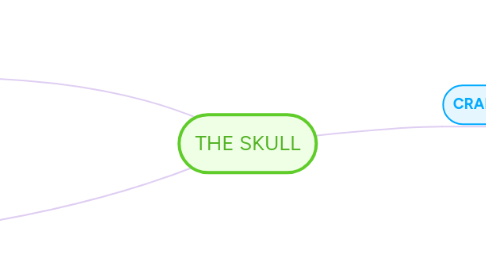
1. Often fractured by blow to the nose
2. FACIAL BONES
2.1. INFERIOR NASAL CONCHA
2.1.1. Seperate bone
2.1.2. Not part of ethmoid like the superior & middle concha or turbinates
2.2. LACRIMAL BONES
2.2.1. Form part of medial wall of each orbit
2.2.2. Lacrimal fossa houses lacrimal sac in life
2.2.2.1. tears collect in lacrimal sac & drain into nasal cavity
2.3. MANDIBLE
2.3.1. Only bone of the skull that can move
2.3.1.1. jaw joint formed between mandibular fossa of temporal bone & condyloid process
2.3.2. Hold the lower teeth
2.3.3. Attachment of muscles of mastication
2.3.3.1. temporalis muscle onto coronoid process
2.3.3.2. masseter muscle onto angle of mandible
2.4. MAXILLA
2.4.1. Forms upper jaw
2.4.1.1. alveolar processes are bony points between teeth
2.4.1.2. alveolar sockets hold teeth
2.4.2. Forms inferomedial wall of orbit
2.4.2.1. infraorbital foramen
2.4.3. Forms anterior 2/3 of hard palate
2.4.3.1. incisive foramen
2.4.3.2. cleft palate
2.5. VOMER
2.5.1. Inferior half of the nasal septum
2.5.2. Supports cartilage of nasal septum
2.6. NASAL BONES
2.6.1. Forms bridge of nose & supports cartilages of nose
2.7. PALATINE BONES
2.7.1. L-shaped bone
2.7.2. Posterior 1/3 of the hard palate
2.7.3. Part of lateral nasal wall
2.7.4. Part of the orbital floor
2.8. ZYGOMATIC BONES
2.8.1. Forms angles of the cheekbones & part of lateral orbital wall
2.8.2. Zygomatic arch is formed from temporal processes of zygomatic bone & zygomatic process of temporal bone
3. CRANIAL BONES
3.1. FRONTAL BONE
3.1.1. Forms forehead and part of the roof and floor of the cranium
3.1.2. Contains frontal sinus
3.2. OCCIPITAL BONE
3.2.1. Rear & much of base of skull
3.2.2. Skull rests on atlas at occipital condyles
3.2.3. Forms roof of the orbit
3.2.4. External occipital protuberance for nuchal ligament
3.3. ETHMOID BONE
3.3.1. Found between the orbital cavities
3.3.2. Forms lateral walls and roof of nasal cavity
3.3.3. Cribriform plate & crista galli
3.3.4. Ethmoid air cells form ethmoid sinus
3.4. PARIETAL BONE (x2)
3.4.1. Forms cranial roof & part of its lateral walls
3.4.2. Bordered by 4 sutures: Coronal, Sagittal, Lambdoid and squamous
3.4.3. Perpendicular plate forms part of nasal septum
3.4.4. Marked by temporal lines of temporalis muscle
3.5. SPHENOID BONE
3.5.1. Foramen rotundum & ovale to trigeminal nerve
3.5.2. Body of the sphenoid
3.5.2.1. Sella Turcica contains deep pit (hypophyseal fossa)
3.5.3. Lesser Wing
3.5.3.1. Optic foramen contains optic nerve & opthalmic artery
3.5.4. Houses pituitary gland
3.5.5. Greater Wing (3 Foramen)
3.5.5.1. Foramen spinosum for meningeal artery
3.6. TEMPORAL BONE (x2)
3.6.1. Forms lateral wall & part of floor of cranial cavity
3.6.1.1. Squamous part
3.6.1.1.1. Zygomatic Process
3.6.1.1.2. Mandibular Fossa
3.6.1.1.3. Temporomandibular Joint
3.6.1.2. Tympanic Part
3.6.1.2.1. External Auditory Meatus
3.6.1.2.2. Styloid process for muscle attachment
3.6.1.3. Mastoid Part
3.6.1.3.1. Mastoid process
3.6.1.3.2. Mastoid notch
